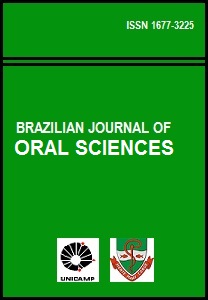Abstract
The aim of this study was to evaluate the preparation of the cervical two thirds of curved canals after using two different endodontic rotary instruments, i.e., Gates-Glidden drills and Orifice Shaper. 20 mesial roots of mandibular molars were used and analyzed before and after instrumentation. The teeth were then placed in clear resin blocks and thus it was possible to remove the resin blocks from the mold, cut them 3 mm below the root bifurcation, and analyze the teeth. The blocks were then reassembled in the mold so that the canals could be instrumented. The area of the mesial canal and the least radicular thickness between furcation and mesial root were measured using an image analyzer computer program. The amount of dental tissue removed by the two instruments was greater towards the furcation. The mean area of the canals prepared with the GG drill was 0.63mm2 and the mean area of the canals prepared with the OS was 0.47mm2 . The average thickness between the mesiobuccal canal prepared by the GG drill and the furcation was 0.72mm and the average thickness between the mesiolingual canal instrumented by the OS and the furcation was 0.81mm. The remaining radicular thickness between the distal wall of the mesial root and the lumen of the canals prepared with either the Gates-Glidden drills or the Orifice Shaper was not significant (P>0.05).The Brazilian Journal of Oral Sciences uses the Creative Commons license (CC), thus preserving the integrity of the articles in an open access environment.
Downloads
Download data is not yet available.

